Menu
So you bought your own shipping container and are using it for storage. One of your first queries after purchasing a cargo container is “What should I do to maintain and care for my shipping container?” Maintaining a shipping container is not difficult, but does require some basic knowledge and regular maintenance.
The good news is that because of their construction, shipping containers are built of heavy gauge steel and are intended to endure many years with minimal upkeep. However, that does not mean you can forget about your container entirely.
You may anticipate your shipping container to last at least 15-20 years. When a shipping container is no longer in use for international cargo transport, it is sold as a wind and watertight unit in the storage market or reemployed for alternative purposes. Your sea container may easily last you another fifteen or more years if properly maintained and planned for.
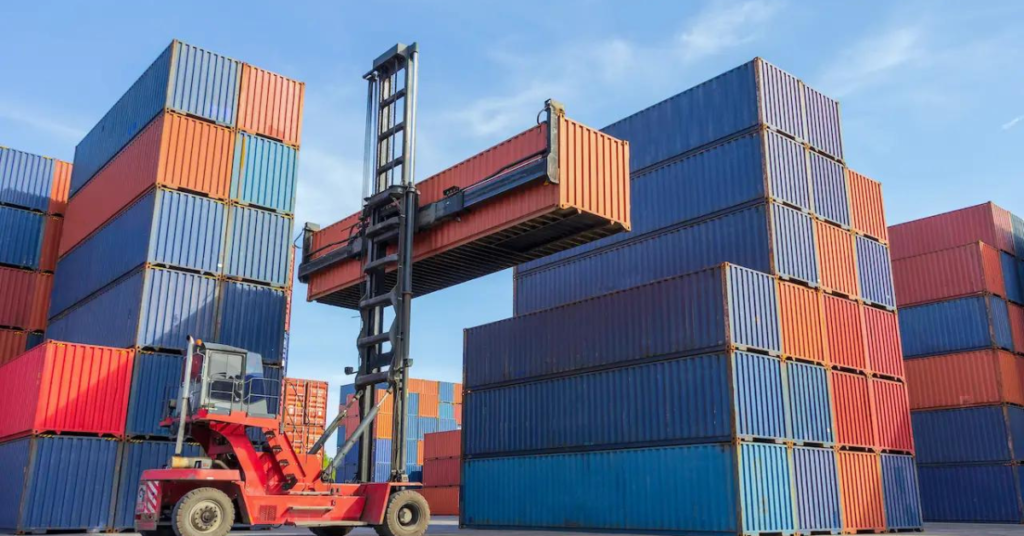
To maintain your storage container in top condition, schedule an annual checkup on your calendar. Examine the metal frame parts of the box for any signs of structural rust, and inspect the roof particularly where water may have gathered for any length of time. Check the rubber door gaskets for wear or deterioration. Old seals become brittle and no longer maintain a watertight
If you react promptly to any issues, do a minimal amount of upkeep, and address them early on, you may avoid time and money in the long run. The shipping container maintenance depends on your climate and how fast they deteriorate.
Anyone who has owned a vehicle in a wet, temperate zone understands that moisture, snow, and freezing temperatures accelerate metal deterioration compared to a warm, dry environment (such as Arizona for example).
To help ensure the longest possible life for your cargo container storage, we’ve put up a few pointers for your shipping container maintenance and repair.
Shipping containers have excellent heat conductivity. The steel surfaces of the container walls cool rapidly as the outside air temperature falls from day to night. Once cooled sufficiently, the metal surfaces will attain what we refer to as the “dew point,” which is the temperature at which airborne water vapor condenses back into a liquid again.
When moist air comes into contact with the cold metal container walls, it condenses from a vapor to its liquid state, creating water droplets on the steel surfaces – most of the condensation collects on the ceiling. The danger of container rain harming your stored items is higher in areas where there is a big temperature difference between daytime and nighttime.
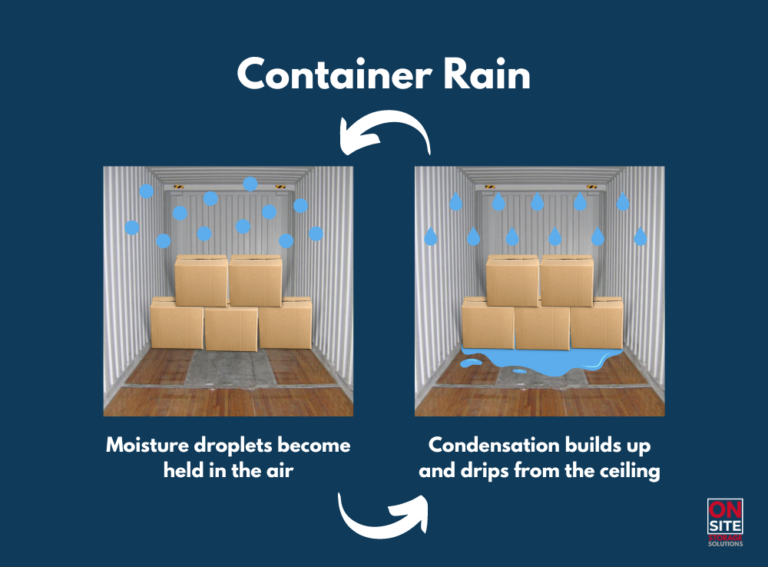
Shipping containers have excellent heat conductivity. The steel surfaces of the container walls cool rapidly as the outside air temperature falls from day to night. Once cooled sufficiently, the metal surfaces will attain what we refer to as the “dew point,” which is the temperature at which airborne water vapor condenses back into a liquid again.
When moist air comes into contact with the cold metal container walls, it condenses from a vapor to its liquid state, creating water droplets on the steel surfaces – most of the condensation collects on the ceiling. The danger of container rain harming your stored items is higher in areas where there is a big temperature difference between daytime and nighttime.
There are three crucial aspects to consider when reducing moisture condensation in your storage container.
Examine the container ceilings and walls for visible moisture condensation. Examine the inner surfaces of the container before loading it to ensure there is no standing water and dry any moisture that may have gathered.
If you live in a humid area, adding insulation to the walls of your container will help to keep the temperature down. The temperature of the walls will drop below the dew point as a result of insulating them, resulting in no condensation.
Installing a Vapor Barrier – A vapor barrier can help prevent condensation on the container walls. A vapor barrier is any material used to dampproof a building. A plastic sheet, for example, is commonly used as a moisture barrier on walls, doors, plywood flooring, and ceilings.
In the container, you may use desiccants to keep humidity at a low level. Desiccants are “hygroscopic materials” that absorb moisture from the air.
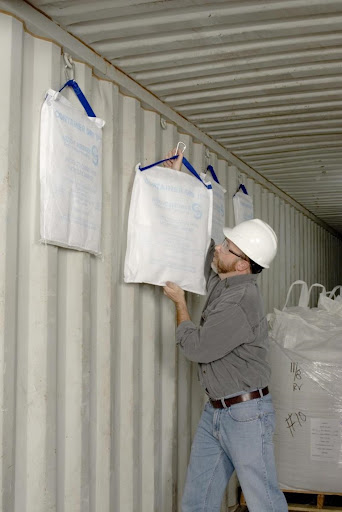
Consider those “Do Not eat” silica gel packets that are often included in bottles of food supplements or product packaging. Desiccants are often in strips on walls or hanging from the ceiling, or in bags on the container’s floor. Every 10 to 12 weeks, desiccant bags should be replaced – depending on the season and your local weather conditions.
Consider the ventilation. Think about your surroundings. If your container will be kept in a hot climate with a big day-to-night temperature range, you may need to take additional precautions to avoid “container rain.”
Containers are frequently renovated and have vents installed. Opening the door enables air circulation and prevents heated air from accumulating inside the container. This easy procedure may go a long way toward mitigating condensation’s detrimental effects.
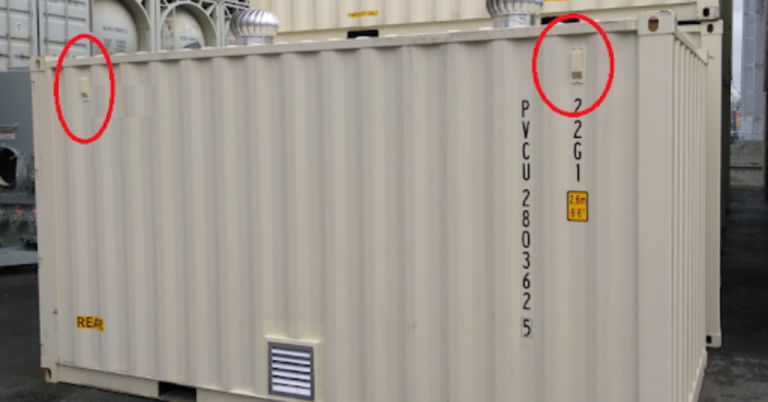
Only store 100% dry stuff in the storage box. Fresh wood, for example, can have an extremely high moisture content. This means that the materials’ own moisture may cause humidity levels to rise inside the container since it releases moisture into the air from within.
Place moisture-sensitive goods (such as furniture or cardboard boxes) in a location that minimizes the likelihood of water droplets condensing and collecting on them. Because some products (ex. electronics, dried foodstuffs, cardboard boxes of paper documents that are prone to mold) may be vulnerable to moisture accumulation, be prepared.
Even though Conex containers are designed to be watertight and be used in all weather conditions, they are ultimately made of steel and thus it is not rust-proof and susceptible to the problem of rust.
The good news is that most shipping containers are manufactured out of corrosion-resistant Cor-Ten steel and we can take measures to protect against the onset of rust and slow its corrosive effects.
If you purchased an “as is” container, it is quite likely that a used shipping container has had a lot of exposure to salt water and salt air which all accelerate corrosion. A 1-trip or new container will not have that degree of corrosion.
When iron comes into contact with oxygen in the air or chloride in water, it forms rust. Anti-corrosive qualities are present in marine grade steel, but since containers are subjected to intense, maritime conditions, it will eventually rust.
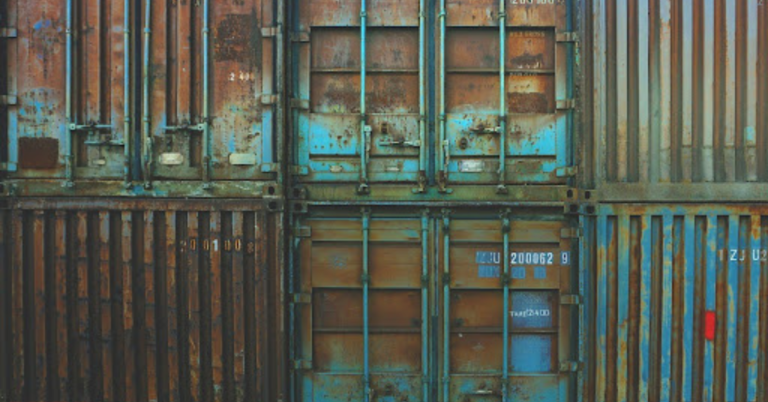
When a shipping container is exposed to both oxygen and water, an oxidation chemical reaction takes place. The combination of steel, water, and oxygen yields hydrated iron (III) oxide, which we perceive as rust. If the metal surface of a shipping container is damaged during transportation, it can start to corrode.
When the container is struck while being loaded, the outer protective layer on the outside of the container may be damaged and bare metal exposed, providing a foothold for oxidation to begin.
The most visible rust on the outside walls of a container is “non-structural” rust, which shows on the surface of the walls. Surface rust is unattractive and might rub off onto and discolor products that come into touch with it, lowering its resale value. A visibly rusted container may not be dangerous to humans, but few people want to purchase or view one.
The second (and more dangerous) form of container rust is known as “structural rust.” Structural rust in this advanced stage has begun to jeopardize the container’s structural integrity. Due to structural instability, serious structural rust might render a container unusable for many applications.
The container may not be certified CSC if there is significant structural rust. As CS stands for “Container Safe Convention” refers to a container, which is safe for use and capable of withstanding the sometimes strong strains of transporting freight across the country or overseas. It must be examined and certified in accordance with worldwide laws. ”
When it comes to small surface rust problems, the sooner you detect them, the less likely they are to develop into bigger issues. If you catch them early enough, the rusted area is simple to treat and remove, resulting in fewer troubles down the road. Scrapes, dents, and scratches should be addressed as soon as possible in order to avoid more corrosion damage from turning a non-structural problem into a structural one.
Rust should be addressed as soon as possible. Prior to sanding, any visible rusted areas should be brushed or sanded down with a wire brush or sandpaper. When it comes to properly removing rust, the most important thing is to sand down to bare metal where you can no longer detect any signs of rust. After the visible surface rust has been removed, clean the bare spot with vinegar and allow it to dry.
Apply rust-inhibiting primer or DTM paint to your wooden kitchen worktop for protection. If the exterior container walls are badly rusted, you should sandblast them and seal them before repainting the container. For most storage applications, the costly and time-consuming process of sandblasting and completely refurbishing the container is not necessary. For more ways to avoid rust on your containers read here
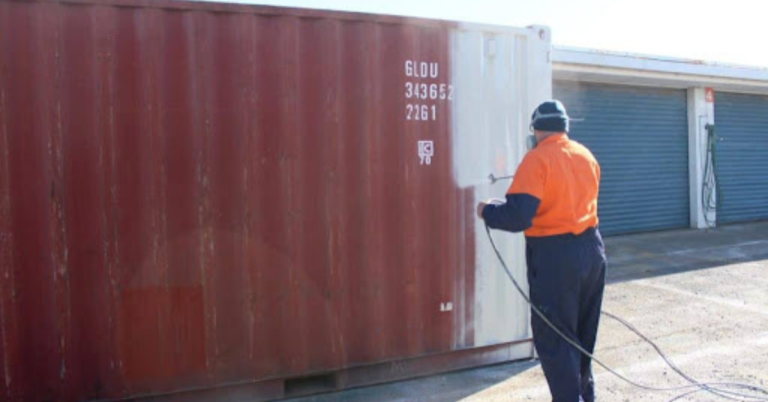
To paint a 20-foot container, use four gallons of paint; to cover a 40 foot container, you’ll need eight gallons. By sanding any visible rust spots, you can prepare your container for primer or paint application. A pressure washer is ideal for removing any layers of grime and dust from the surface. Rust patches should be sanded down with a wire wheel or sandpaper.
To ensure that the top coat of paint adheres to the metal, apply a rust-inhibiting primer coat over the location first. Check with your local paint store to see if they have any suggestions on what primer would be best for outdoor metal surfaces. Allow adequate time for the primer coat to dry completely before applying the final, top coat of paint. For more tips on how to repaint your containers, read here!
There are several alternatives to choose from, depending on your requirements, the availability of paint, and your budget.
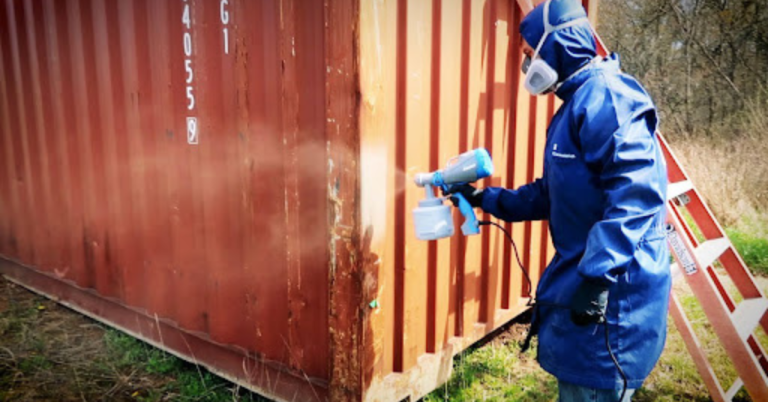
The kind of paint you select for your container is determined by how you plan to utilize it.
1) Water-based paints (which are better for the environment and have lower VOC levels) can also be used. Water-based paints, when compared to traditional oil-based paints, may inhibit rust as effectively or even better.
2) Industrial-grade alkyd enamel paints are affordable and simple to use by non-professionals. Your alkyd enamel finish should last for approximately five to ten years.
Polyurethane paint is a tough-duty paint that people commonly use in industrial applications. It’s vital to note that the chemicals in the paint might be more dangerous. Because there are specific mixing and application instructions for polyurethane paint, you may wish to hire a professional to apply it for you.
4) Zinc-based paint is a good way to prevent rust from developing on your container. Zinc paint offers decent protection against shipping container rust. The zinc in the paint delays the formation of rust on the steel beneath it by employing what’s known as “cathodic protection.”
In most situations, sandblasting the entire container is not a good idea. Because you must hire a specialist with the right tools to sandblast an entire container, it’s an expensive procedure that might completely remove much of the excellent protection offered by high-quality marine paint. Because a home paint job will not provide the same level of rust protection as the original marine paint, it is essential to prime and then repaint over it.
The simplest step you can take to protect yourself from the dangers of water and rust is to place your shipping container on a level surface, rather than in a low-lying depression where rainwater will accumulate.
If puddles of water accumulate beneath or around the container, rust will soon develop. If your container is placed directly on the ground, its bottom will be in touch with moist soil and become more susceptible to rusting.
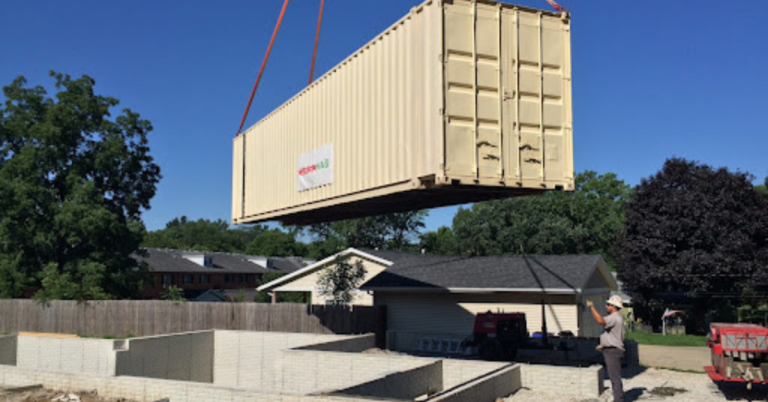
To begin, choose a site that is on solid and level ground. A simple foundation of concrete blocks or railroad ties is recommended for setting up your container; it will also aid in the improvement of air circulation under the container. The bottom of the container doors is a common area to look for, as water tends to accumulate there.
Although shipping container doors are basic structures with few moving components, we do need to maintain them.
The most basic and straightforward option is to lubricate the container door hinges. Metal hinges can get gummed up after a long period of inactivity. Apply an all-purpose oil like wd-40 to ensure that your containers will keep the hinges and lockings from rusting and help them function properly.
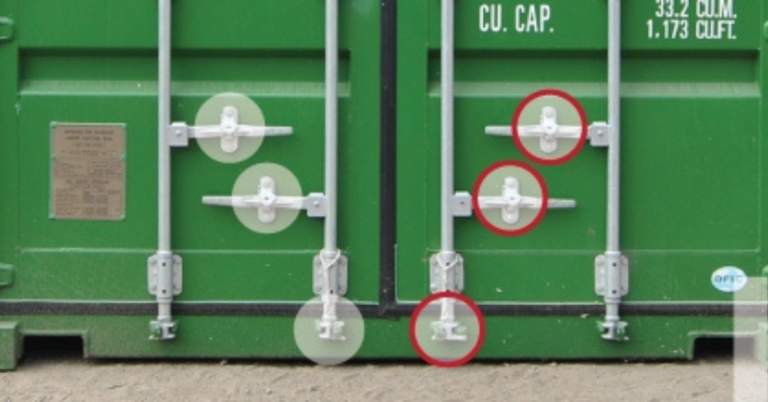
Watertight sealed containers are built to be watertight sealed and the metal doors use rubber gasket-type seals. Rubber generally has a lifespan of approximately ten years before cracking, deteriorating, and losing its ability to properly seal the door against moisture.
If the seals become completely destroyed, you can replace them with a container door gasket kit available online. You can guarantee that your shipping container storage unit keeps your belongings for a long time if you follow these guidelines.
If you’re searching for storage solutions that are both flexible and affordable, look no further than On-Site Storage Solutions. Our extensive selection of shipping container sizes can be purchased or rented, and we offer financing programs to make them more accessible for our clients. With over 60 depot locations across the USA and Canada, we can provide quick and dependable delivery. Don’t hesitate to call us at (888) 405-8772 to discover more about our rates and begin your storage project today.
